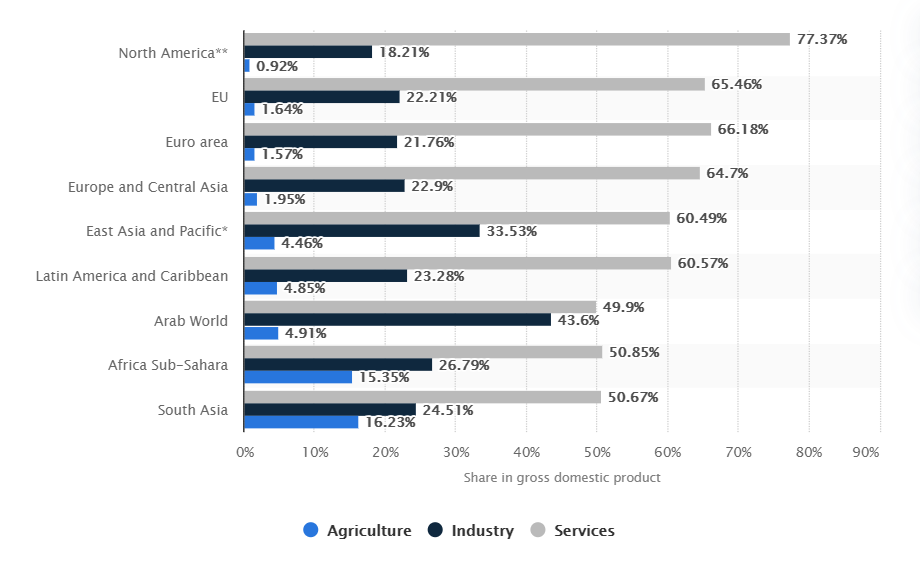When we are talking about eCommerce in agribusiness, it is crucial to understand that it presupposes something significantly more severe than just launching a website for making online orders. Transition to the eCommerce model includes more profound changes in the way of interaction between different market participants and new approaches to doing business.
But even given all benefits of going digital, can eCommerce become a solution for farmers today? Or is there still a long way to go? Furthermore, can we expect the digital revolution in this sector in the nearest future, or are there any major pitfalls? (Spoiler: There are some). This article will share our thoughts on how agribusiness is changing today amid the development of so-called agtech (agricultural technologies) and how custom eCommerce solutions can support these transformations.
Digitalization of the Agricultural Sector
What does a traditional agricultural supply chain look like? First, there are many middlemen involved in the process of passing produce from farmers to end consumers. Second, as each intermediary has to earn a margin, it is evident that farmers get only a tiny part of the amount paid by consumers. eCommerce in agribusiness helps to facilitate many procedures, make them faster, and provide farmers with more earning opportunities.
As a result, farmers can increase their profits, while end consumers can get fresher products and more precise information about them and their origin.
These changes may seem relatively insignificant for urban areas but let’s not forget that there are some regions where over 97% of the population is involved in agribusiness. This sector is one of the key contributors to the local GDP.
Share of Economic Sectors in the GDP of Selected Global Regions in 2019
Though the eCommerce revolution can help economies thrive, let’s look at the advantages of agtech solutions from a personal perspective. What value can they bring to the lives of farmers and their families?
eCommerce for Farmers: Key Benefits
- Increase of revenues. With online platforms, farmers can tell the local communities about themselves and get many new earning opportunities. Moreover, selling products directly to consumers also helps to get higher profits.
- Better financial inclusion. In the traditional system, farmers practically do not participate in the financial industry. Many cash transactions with intermediaries are informal and are conducted even without a receipt. As a result, farmers do not even have any official records of their sales. With software solutions, they can openly make official transactions and keep their records and build their financial history. And they will be able to demonstrate their creditworthiness to financial and banking institutions for getting access to loans, investing, and other funding options.
- Reduction of wastage. eCommerce platforms make it possible to reduce the time needed for products to reach end consumers. For example, going online, farmers can sell fresher vegetables and fruits and minimize the risks of post-harvest wastage.
- Enhanced productivity. In combination with consumers’ interest in tracing the origin of the food they buy, all three points mentioned above can become great incentives for farmers. As a result, they are more motivated to expand their activities, improve the quality of their products and increase investments in agricultural machinery and planting methods.
- Better external investing. Agri e-commerce services positively influence the development of related services in the region, like logistics and mobile finance. In their turn, these related services can promote the financial and digital inclusion of many gamers, even the poorer ones, and increase the investment attractiveness of the sector.
Three Approaches to the eCommerce Revolution
There are three critical approaches to the “eCommercialization” of agribusiness that we can observe today, mainly in the developed region of the US and Europe.
- Well-known eCommerce platforms are entering the grocery segment. The brightest example of this tendency is Amazon Fresh, same-day grocery delivery by Amazon. With the help of such giants, small farmers can get access to the market faster and easier.
- Online solutions offered by offline stores. Offline stores are coming online (and the coronavirus lockdowns have also contributed to this trend), offering new options for farmers and consumers.
- Online-only Agri eCommerce businesses. That’s probably the case that will be the final stage of the transition to the eCommerce model. Such solutions are aimed at establishing direct links between farmers and end consumers. Today the majority of these projects are in their startup phase. But, of course, it’s just the beginning. Platforms of this type are actively growing. For example, Devon-based Riverford reported a 13.5% turnover growth to $104.5 million for the 52 weeks to 30 April 2020. For farmers, there is also another option. They can sell their produce to intermediaries who, in their turn, sell them to eCommerce platforms. However, this approach has several disadvantages if compared with the situations when farmers work with marketplaces directly.
Boosters for Agribusiness eCommerce Development
Even in the developing regions, today, we can observe several tendencies that show us that the integration of Agri eCommerce services is possible.
- Mobile internet penetration is growing. It leads to an increasing number of people who can use eCommerce solutions.
- Logistics networks are expanding. Now even those farmers who are based in the most remote areas can get the possibility to deliver their produce to urban areas.
- The popularity of online payments is growing. Earlier farmers work only via cash transactions, and now digital payment methods can be applied, which is a good option when you want to sell or buy something online.
- General urbanization is still gaining momentum. Some decades ago, much more people lived in rural areas where they all could plant their vegetables and crops. Now, with more people living in towns and cities, the demand for farming produce is rising.
- People want to know more about the products that they buy. Today, as there is a lot of information about the importance of healthy food and natural products, people’s awareness is growing. In addition, consumers want to see when, where and by whom goods are produced. eCommerce platforms can provide the necessary transparency.
- Today more people start using eCommerce services. Even without mentioning agribusiness and farming, we can see that people actively use online marketplaces. And it is one more good tendency that can support the development of eCommerce platforms in agriculture.
eCommerce in Farming: Challenges
But as we have stated before, some pitfalls can be viewed as barriers to the eCommerce revolution in agriculture.
- Many consumers prefer to buy fruits and vegetables in traditional offline stores as they want to see with their own eyes what they are buying.
- Many farmers who live in poorer districts do not have access to stable internet and mobile devices.
- Issues with logistics and warehousing still exist in many regions.
- Intermediaries control Agri supply chains, and it is not easy to immediately exclude them from all the processes.
Is it possible to overcome these barriers? Definitely yes. But, of course, that’s the question of time and efforts from the side of all market players.
Software Solution for Farmers
Each area has its peculiarities which result in specific demands of local communities. Let’s look at some solutions that have already been built for the needs of developing regions.
| Country | Solution | Description |
|---|---|---|
| Tanzania | Ninanyo | A marketplace that allows farmers to sell their products. |
| Nigeria | Farmcrowdy | A platform that helps to establish connections between farm sponsors and investors with real farmers. |
| Gambia | FarmFresh | The first online food store in the country that offers fresh products from local farmers. |
| Kenya | Twiga Foods | A platform that links farmers with fair markets in urban areas. |
| Colombia | Frubana | A B2B solution that changes traditional agro supply chains in the country by enabling farmers to sell their goods directly to small retailers and restaurants. |
| Indonesia | Eragano | A solution for farmers that helps them to get access to marker, crop insurance, and microfinance. |
| Pakistan, Thailand | Ricult | A mobile app that helps farmers sell their products and provides them with the most relevant information regarding weather, rainfall, and humidity. Farmers also have access to chats and forums to exchange tips and information to increase their farms’ productivity. At the same time, lenders who offer loans to farmers can benefit from credit score and risk monitoring features. |
Of course, this list represents only a tiny part of the solutions available today. However, even based on this information, we can understand the most popular tasks of eCommerce solutions in agriculture.
The most widely spread functionality of agtech solutions on the global market are the following ones:
- B2C solutions for selling products directly to end consumers with the possibility to exclude intermediaries from the supply chains;
- B2B platforms that offer wholesale options;
- Farmers-to-farmers social networks;
- Farmers-to-restaurants platforms;
- Marketplaces that allow farmers to sell, buy or rent agricultural equipment and machinery;
- Agriculture insurance and loan solutions;
- Crowdfunding for farmers.
If you have an innovative idea and need a reliable team to realize it, you are just on the right website. Geomotiv experts are here to help you!
Our team helps startups to transform their ideas into ready-to-use solutions. Suppose you choose us as your IT partner. In that case, we will apply our deep theoretical knowledge and rich practical skills in building eCommerce solutions to deliver a software product that will bring real value to its users.
We are ready to provide our assistance starting from the earliest steps of your project development. In our blog, we’ve already shared some tips on choosing the best business model and monetization strategy for your eCommerce marketplace (to read them, just follow this link).
We will help you study the market demand and find the most appropriate features to address the existing issues in the agricultural sector. Let’s support local communities with advanced eCommerce solutions together! Leave your inquiry, and our experts will contact you as soon as possible.







